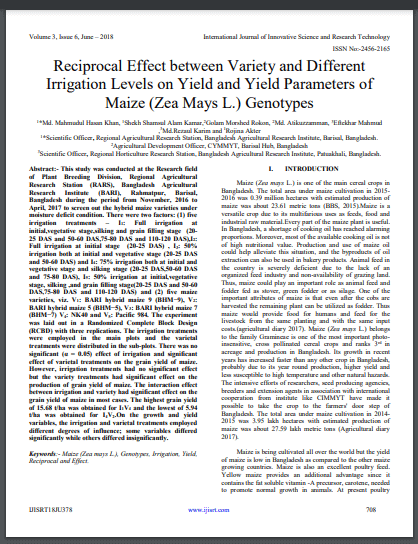This study was conducted at the Research field of Plant Breeding Division, Regional Agricultural Research Station (RARS), Bangladesh Agricultural Research Institute (BARI), Rahmatpur, Barisal, Bangladesh during the period from November, 2016 to April, 2017 to screen out the hybrid maize varieties under moisture deficit condition. There were two factors: (1) five irrigation treatments – I1: Full irrigation at initial,vegetative stage,silking and grain filling stage (2025 DAS and 50-60 DAS,75-80 DAS and 110-120 DAS),I2: Full irrigation at initial stage (20-25 DAS) , I3: 50% irrigation both at initial and vegetative stage (20-25 DAS and 50-60 DAS) and I4: 75% irrigation both at initial and vegetative stage and silking stage (20-25 DAS,50-60 DAS and 75-80 DAS), I5: 50% irrigation at initial,vegetative stage, silking ,and grain filling stage(20-25 DAS and 50-60 DAS,75-80 DAS and 110-120 DAS) and (2) five maize varieties, viz. V1: BARI hybrid maize 9 (BHM−9), V2: BARI hybrid maize 5 (BHM−5), V3: BARI hybrid maize 7 (BHM−7) V4: NK40 and V5: Pacific 984. The experiment was laid out in a Randomized Complete Block Design (RCBD) with three replications. The irrigation treatments were employed in the main plots and the varietal treatments were distributed in the sub-plots. There was no significant (α = 0.05) effect of irrigation and significant effect of varietal treatments on the grain yield of maize. However, irrigation treatments had no significant effect but the variety treatments had significant effect on the production of grain yield of maize. The interaction effect between irrigation and variety had significant effect on the grain yield of maize in most cases. The highest grain yield of 15.68 t/ha was obtained for I1V4 and the lowest of 5.94 t/ha was obtained for I4V2.On the growth and yield variables, the irrigation and varietal treatments employed different degrees of influence; some variables differed significantly while others differed insignificantly.

